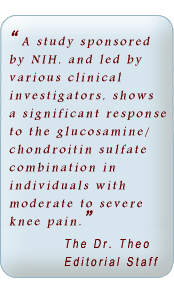GAIT Trial Results
Current News
Past News
Home Page
News
Supplements
Resources
Products
Books
Q & A
About Dr. Theo
 
|
NIH (NIAMS) GAIT (Glucosamine/Chondroitin Arthritis Intervention Trial) Part 2
Do glucosamine, chondroitin alone or in combination, or Celebrex® slow or stop the loss of cartilage in the knees (as measured by x-rays)? That's was the original intent of this study.
The authors broke their own rules as to what would be allowed for this study to be valid but went ahead anyway and published their suspect results.
That's like saying there's no evidence that Tiger Woods is a better golfer than Dr. Theo. Yes, they did only play four holes, in the dark, and used brooms instead of golf clubs, but Tiger didn't beat Dr. Theo so he's no better. Then the media runs out proclaiming, "Tiger no better than Dr. Theo in golf," in every paper across the country and abroad.
The lead author of the study and the
Why was this study was invalid and should not been able to get published?
Here are the top five reasons:
1) The sample size was too small (only 357 subjects). They required more people to have a statistical significance. They predicted they'd have hundreds more to assess.
2) The study length was too short (two years). In the two best glucosamine x-ray studies (Reginster and Pevelka), most of the change from baseline occurred after year two.
3) The x-ray methodology was not sensitive enough to deliver meaningful measurements. the precision error of the x-ray technique was a whopping 0.16 mm. This is as large as the loss of cartilage in the placebo group over the entire two-year period. This alone invalidated the study. imagine trying to report somebody's weight as 150 pounds when the scale has a error margin of 150 pounds! It's essentially useless.
4) The researchers allowed subjects who had been previously exposed to glucosamine and chondroitin to participate in the study. Since the effect of these supplements are known to stick around for years, people who were assigned to the placebo or Celebrex groups would appear to not lose as much cartilage as they should have lost. For the placebo group, this was proven since the placebo users lost very little cartilage, compared to what was seen in other studies using similar x-ray techniques. No previous study was done using Celebrex for comparison.
5) Those in the placebo group lost less than half the expected amount of joint space width on x-ray. This was incredibly important since each of the treatment groups results were dependent upon direct comparison to the results from those in the placebo group. Therefore, there's no possible way the supplements could have shown a benefit if the placebo users didn't significantly change their joint space from the beginning to the end of the study. This is another reason, even taken alone, that this entire study is invalid.
Introduction:
This study was funded by your tax dollars. GAIT Part 1 was a six-month assessment of pain and function in 1,588 patients with osteoarthritis. The study subjects were randomly assigned to one of five groups: placebo, glucosamine, chondroitin, the combination of glucosamine and chondroitin, or the prescription drug Celebrex.
GAIT 2 was an 18-month continuation of slightly less than half of the number of patients that were involved in GAIT part 1.
Investigators were supposed to continue the outcome measures of GAIT part 1, including pain and function, along with a careful assessment of how much rescue medication (acetaminophen) was needed by participants in each group. GAIT part two was also supposed to measure, using x-rays, the space between the bones in the knees of the participants (commonly referred to as joint space width or JSW). JSW is a surrogate measure of cartilage thickness. The more narrow the space between the bones, the lower the quantity of cartilage exists in the joints.
What did the researchers find?
Those who took glucosamine almost halted their loss of joint space width (they only lost 0.013 mm over two years) but this was not considered to be statistically significant. The other 3 groups were closer to placebo in their JSW loss.
Did the treatment fail or did the study fail?
The study failed. The results shouldn't have even been published. Perhaps this explains the long delay. It appears that the authors manipulated data with a number of statistical adjustments. They refer to this in the article. The study was submitted and subsequently revised.
At least the authors admitted some of the numerous problems each which could have voided the data.
They freely admit this in the discussion section on page 3188 that "the power of the study was limited by a smaller than anticipated sample size, increased variability of the measurement, and a smaller than expected loss in JSW."
Add to this the fact that some users had past exposure to glucosamine and chondroitin (which appears to slow the loss of cartilage for years and probably explains the low level of Joint Space Narrowing in the placebo group), and that the study subjects took supplements three times daily, which causes two problems: lower concentration and effectiveness, and poor compliance (since virtually no one will take six capsules a day, split into three daily doses for a period of two years).
To make matters worse, since there were four different treatment groups and a placebo, the statisticians had to apply a statistical correction factor. This in essence, raised the bar to show a treatment to be statistically significant.
Suspicion surrounding the study
When GAIT part 2 was being designed, there was supposed to be an accounting of the use of rescue medication -- namely acetaminophen. it's important to know if one treatment intervention has the ability to allow for subjects to consume lower quantities of rescue medication as this has substantial public health implications. Any intervention which could reduce the amount of acetaminophen used during the study might be recommended solely based on this outcome. Acetaminophen, even in low doses, was shown to almost double the incidence of high blood pressure in a major study involving women (The Nurse's health study). Acetaminophen is also the number one cause of intentional and unintentional medication induced liver failure according to the CDC.
It's also strange that a major component to the original study protocol was left out of this publication- the effect of the supplement treatments and Celebrex on pain and function during a two-year period of time. Were the authors trying to hide the fact that Celebrex might not have had any benefit on pain and function for two-year period of time? Would this affect reimbursement for a drug which costs up to four dollars per day and sometimes requires additional co-medication (acid blockers like Nexium, Prilosec, or Aciphex) costing an extra $2-$6 a day?
Why did the financial disclosures of some of the authors change? For instance, Dan Clegg, MD, the lead investigator for GAIT part 1 disclosed relationships to Pfizer (Celebrex) and McNeil (acetaminophen), the two drugs use in GAIT part I and 2. In GAIT part 2, there was no mention of these associations. It's one thing for people to disclose any relationships to companies that make the supplements. It's just as important for the authors to disclose if they receive financial benefit, directly or indirectly from companies who are competitors of these supplements, especially since Celebrex and acetaminophen were the two drugs used in the study. This is really important, these authors often have direct control of the data. It's a very different story when someone, like myself has ties to various supplements and pharmaceutical entities but is just commenting on the study (and does not have the ability to manipulate the data and outcome).
The authors did not do the public a service by publishing this data.
This was the problem with the first part of GAIT as well. Rather than just stand up and say that they designed and implemented a study that didn't work and they shouldn't report the results for fear of giving the public improper information, these authors, and the journal in which this article appeared, went ahead and published the study anyway and drew conclusions - which were unfounded. Unfortunately, the media will pick up on this and relay a faulty message to the public that the supplements didn't work. These articles have already started to appear.
If you follow the same line of reasoning, then the media should report that Celebrex did not "work" either and, most importantly, that Celebrex resulted in a loss of joint space width 8.5 times greater than those who took glucosamine (0.013 mm lost in two years for glucosamine and 0.111 mm loss for Celebrex).
If the media wanted to be really aggressive with the message, they should go on to say that it could be considered malpractice to prescribe Celebrex for osteoarthritis. Not only did Glucosamine outperform Celebrex by a substantial margin, but the cost of glucosamine is less than 1/10th that of Celebrex. Furthermore, Celebrex is associated with bleeding, high blood pressure, kidney damage, and some major cardiovascular problems. These have not been noted with glucosamine.
I'm sure we'll be debating this today for a long time. It's really too bad that the higher quality studies on glucosamine and chondroitin don't get the same attention in the media.
Dr. Theo's assessment is mirrored by others
Quotes from the NIH (NIAMS) and some of the authors in the study:
Here's what Josephine P. Briggs, M.D., director of the National Center for Complementary and Alternative Medicine, at the National Institutes of Health (NIH), one of the study’s funders had to say: "While these results are of interest, we cannot draw definitive conclusions about the utility of glucosamine or chondroitin in reducing joint space width loss, in part because the placebo group fared better than anticipated based on prior research results. The results of the study provide interesting insights for future research."
"Despite the ancillary study’s limitations, it has provided us with new insights on osteoarthritis progression, the techniques to use to more reliably measure loss of joint space width, the possible effects of these dietary supplements, and the characteristics of osteoarthritis patients that may best respond, all of which will assist investigators in future studies," said Dr. Clegg, professor of medicine and chief of rheumatology and principal investigator for GAIT.
|

Learn about and purchase the book90% of people who follow The Arthritis Cure treatment program don't need anti-inflammatories (like Aleve, Celebrex or Advil).
Dr. Theo warned people that these drugs, used first... read more
|
|


